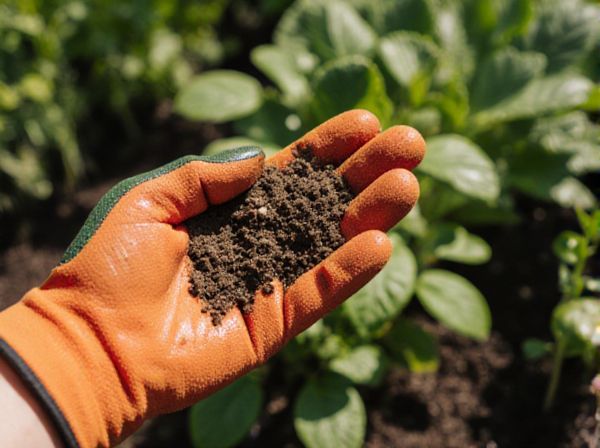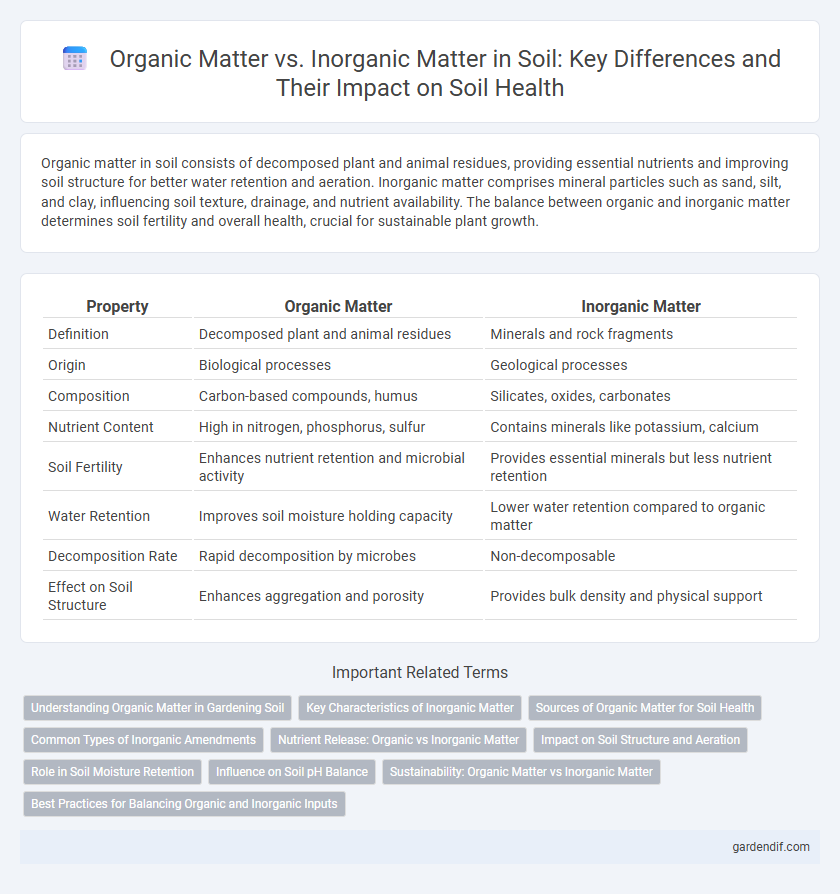
Organic matter vs Inorganic matter Illustration
Organic matter in soil consists of decomposed plant and animal residues, providing essential nutrients and improving soil structure for better water retention and aeration. Inorganic matter comprises mineral particles such as sand, silt, and clay, influencing soil texture, drainage, and nutrient availability. The balance between organic and inorganic matter determines soil fertility and overall health, crucial for sustainable plant growth.
Table of Comparison
| Property | Organic Matter | Inorganic Matter |
|---|---|---|
| Definition | Decomposed plant and animal residues | Minerals and rock fragments |
| Origin | Biological processes | Geological processes |
| Composition | Carbon-based compounds, humus | Silicates, oxides, carbonates |
| Nutrient Content | High in nitrogen, phosphorus, sulfur | Contains minerals like potassium, calcium |
| Soil Fertility | Enhances nutrient retention and microbial activity | Provides essential minerals but less nutrient retention |
| Water Retention | Improves soil moisture holding capacity | Lower water retention compared to organic matter |
| Decomposition Rate | Rapid decomposition by microbes | Non-decomposable |
| Effect on Soil Structure | Enhances aggregation and porosity | Provides bulk density and physical support |
Understanding Organic Matter in Gardening Soil
Organic matter in gardening soil consists of decomposed plant and animal residues that enhance soil structure, moisture retention, and nutrient availability. It supports beneficial microbial activity, improving soil fertility and promoting healthy plant growth. In contrast, inorganic matter includes minerals and rock fragments that provide essential minerals but lack the biological benefits of organic components.
Key Characteristics of Inorganic Matter
Inorganic matter in soil primarily consists of mineral particles such as sand, silt, and clay, derived from the weathering of rocks. These particles determine soil texture, influence water retention, and provide essential nutrients like phosphorus, potassium, and calcium. Unlike organic matter, inorganic components do not decompose but play a critical role in soil structure and fertility by affecting aeration and nutrient availability.
Sources of Organic Matter for Soil Health
Organic matter in soil primarily originates from plant residues, animal manure, and microbial biomass, which enhance soil fertility and structure. Crop residues such as leaves, stems, and roots decompose to supply essential nutrients and improve moisture retention. Animal manure contributes valuable organic compounds and beneficial microorganisms that stimulate nutrient cycling and soil biological activity.
Common Types of Inorganic Amendments
Common types of inorganic amendments include gypsum, lime, and rock phosphate, which improve soil structure, pH balance, and nutrient availability. Gypsum supplies calcium and sulfur, helping to alleviate soil compaction and improve water infiltration. Lime raises soil pH in acidic soils, enhancing microbial activity and nutrient uptake, while rock phosphate provides a slow-release source of phosphorus essential for plant growth.
Nutrient Release: Organic vs Inorganic Matter
Organic matter releases nutrients slowly through microbial decomposition, enhancing soil fertility and promoting sustained nutrient availability for plants. Inorganic matter, such as synthetic fertilizers, provides immediate nutrient release but may cause rapid nutrient leaching and reduced long-term soil health. The balance between organic and inorganic nutrient sources is essential for maintaining optimal soil nutrient dynamics and crop productivity.
Impact on Soil Structure and Aeration
Organic matter significantly improves soil structure by enhancing aggregate formation, which increases pore space and promotes better aeration. Inorganic matter, while contributing to soil mineral content, often lacks the ability to improve soil porosity and can lead to soil compaction if present in excess. The presence of high organic matter content supports microbial activity, fostering an aerated and well-structured soil environment conducive to plant root growth.
Role in Soil Moisture Retention
Organic matter significantly enhances soil moisture retention by improving soil structure, increasing porosity, and facilitating water-holding capacity through its high affinity for water molecules. Inorganic matter, such as sand, silt, and clay particles, influences soil texture and drainage but generally has a lower capacity to retain moisture compared to organic components. Soils rich in organic matter exhibit greater resilience to drought and improve plant water availability by reducing evaporation and promoting deeper water infiltration.
Influence on Soil pH Balance
Organic matter increases soil pH buffering capacity by releasing organic acids that gradually decompose, helping to neutralize soil acidity. Inorganic matter, such as minerals like calcium carbonate, directly alters soil pH through chemical reactions that can either raise or lower pH depending on the compound. The balance between organic and inorganic materials critically influences soil pH stability, affecting nutrient availability and microbial activity.
Sustainability: Organic Matter vs Inorganic Matter
Organic matter enhances soil sustainability by improving structure, water retention, and nutrient cycling, fostering healthy ecosystems and long-term fertility. Inorganic matter, while providing essential minerals, often lacks the biological benefits and can lead to soil degradation if overapplied. Sustainable soil management relies on maintaining balanced organic content to promote resilience and reduce dependency on chemical inputs.
Best Practices for Balancing Organic and Inorganic Inputs
Balancing organic and inorganic inputs in soil management enhances nutrient availability and soil structure, promoting sustainable crop growth. Incorporating compost, manure, and cover crops supplies organic matter that improves microbial activity and water retention, while judicious use of inorganic fertilizers ensures essential nutrient supplementation without causing toxicity. Monitoring soil nutrient levels and adjusting input ratios based on crop requirements and soil tests optimizes the benefits of both input types for long-term soil health.
Organic matter vs Inorganic matter Infographic

 gardendif.com
gardendif.com